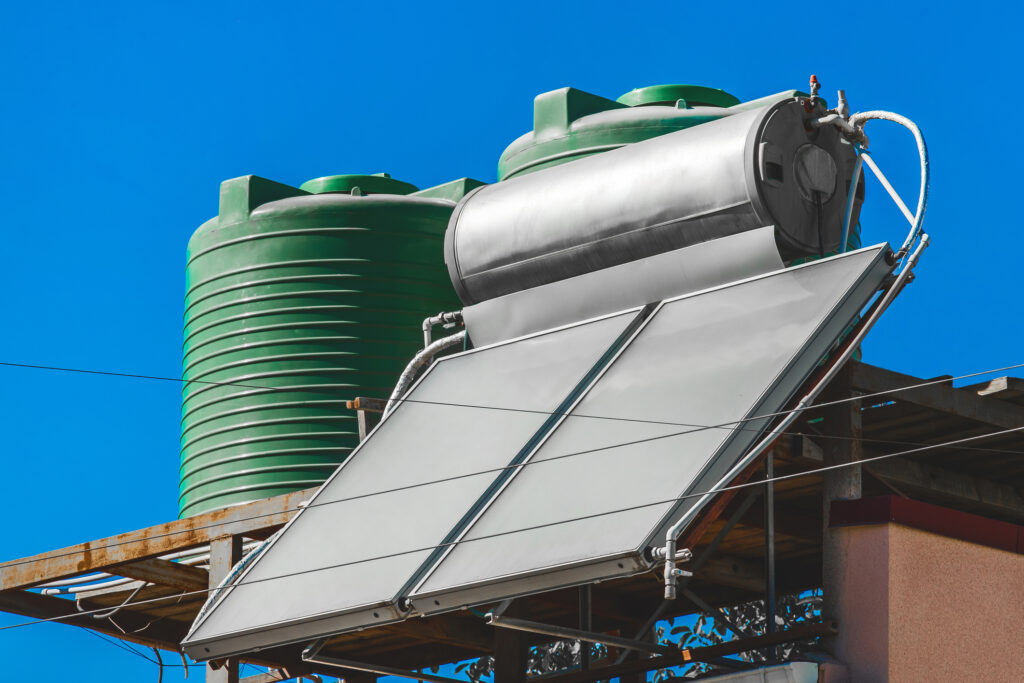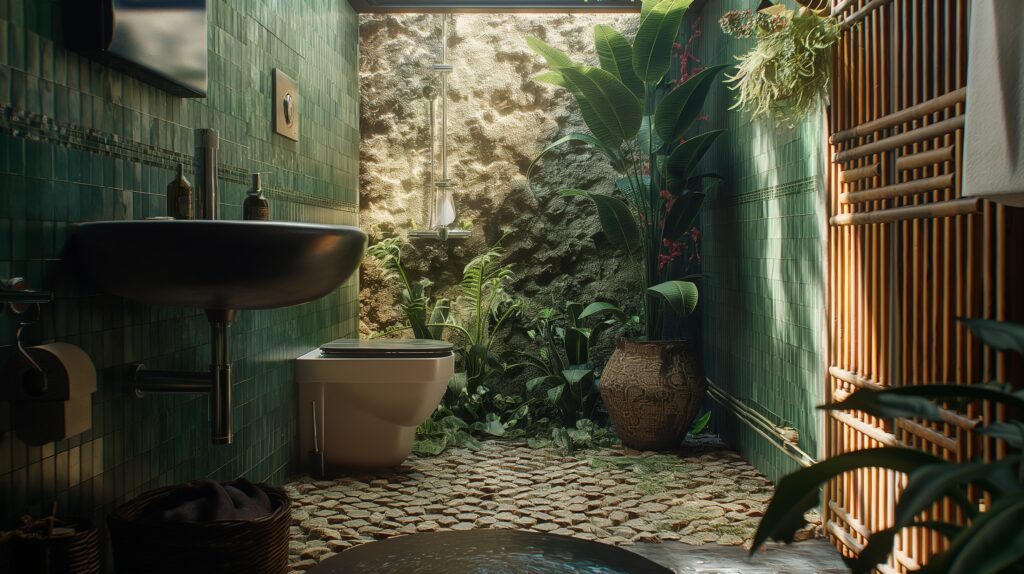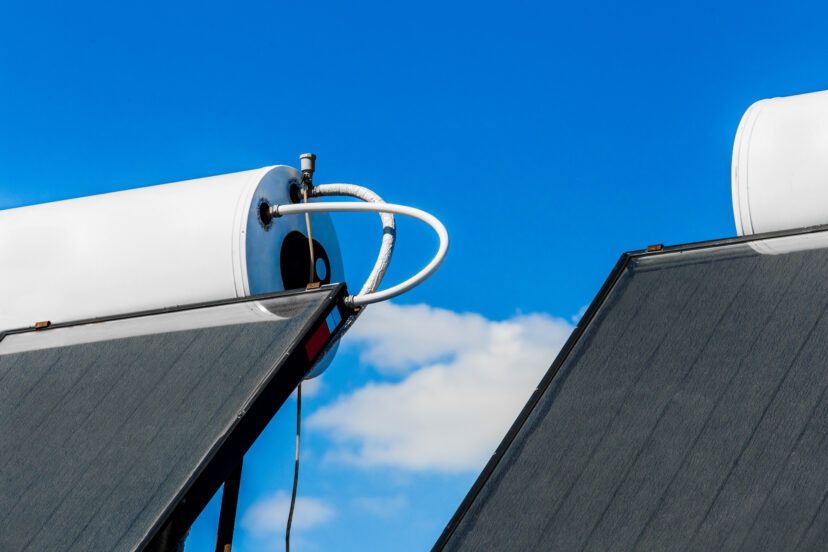Solar Heating for Off-Grid Rainwater: An Implementation Guide
Harnessing solar power to heat rainwater is a smart and sustainable way to ensure a steady supply of warm water in your off-grid home. This approach leverages renewable energy to provide comfort without relying on external power sources, making it an ideal solution for off-grid living. In my opinion this is a critical component to off-grid bathroom design and off-grid kitchen design. Having warm water for taking showers and washing dishes is a must for me! Let’s dive into the process of implementing solar heating for off-grid rainwater:
Understanding Solar Water Heating Systems
Solar water heating systems use solar panels to capture sunlight and convert it into heat. This heat is then transferred to water stored in a tank, making it available for use in faucets and shower heads. There are two main types of solar water heating systems: active and passive.
Active Solar Water Heating Systems
Active systems use pumps to circulate water or a heat-transfer fluid from the solar collectors to the storage tank. These systems are generally more efficient and can be controlled more precisely.
- Direct Circulation Systems: Water is pumped through solar collectors where it is heated and then stored in a tank. This system works well in climates where freezing is not a concern.
- Indirect Circulation Systems: A heat-transfer fluid (such as antifreeze) is circulated through the solar collectors and then through a heat exchanger to warm the water. This system is ideal for colder climates where freezing temperatures can occur.
Passive Solar Water Heating Systems:
Passive systems do not use pumps but rely on natural convection to circulate water. While less efficient, they are simpler and more reliable because they have fewer moving parts.
- Thermosiphon Systems: These systems place the storage tank above the solar collectors. As water heats up, it rises naturally into the tank. This system requires careful placement and installation to ensure proper functioning.
- Integrated Collector-Storage Systems: The solar collector and storage tank are combined into one unit. Water is heated directly in the collector and then stored in the same unit. This system is suitable for regions with mild climates and minimal freezing risks.

Implementing a Solar Water Heating System for Rainwater
Step 1: Collect and Store Rainwater
Rainwater harvesting involves collecting rainwater from your roof and storing it in tanks. Ensure the collection system is clean and the tanks are appropriately sized to meet your household’s water needs.
- Gutters and Downspouts: Install gutters and downspouts to direct rainwater from your roof into storage tanks.
- Storage Tanks: Use large, covered storage tanks to hold the harvested rainwater. Consider installing a first flush diverter to remove debris and contaminants from the initial flow of rainwater.
Step 2: Install Solar Collectors
Solar collectors are installed in a sunny location where they can capture maximum sunlight. These collectors can be mounted on the roof or on ground-based racks.
- Optimal Placement: Position the solar collectors to face the equator (south-facing in the northern hemisphere) at an angle that maximizes exposure to the sun.
- Mounting: Ensure the collectors are securely mounted and have unobstructed access to sunlight throughout the day.
Step 3: Set Up the Storage Tank
Storage tanks store the heated water. For passive systems, the tank should be placed above the collectors to allow for natural convection. For active systems, the tank can be placed in a convenient location with pumps used to circulate the water.
- Insulation: Insulate the storage tank to retain heat and minimize heat loss.
- Connections: Connect the storage tank to the solar collectors and the household plumbing system.
Step 4: Install the Plumbing and Controls
Plumbing and control systems manage the flow of water between the solar collectors, storage tank, and household fixtures.
- Pumps and Controllers: For active systems, install pumps and controllers to regulate the flow of water and ensure efficient operation.
- Mixing Valve: Install a mixing valve to blend hot and cold water, providing a safe and consistent temperature for faucets and shower heads.
Step 5: Maintenance and Monitoring
Regular maintenance ensures the system operates efficiently and lasts longer.
- Inspect Collectors: Regularly check the solar collectors for dirt, debris, or damage.
- Check Connections: Ensure all plumbing connections are secure and free from leaks.
- Monitor Performance: Keep an eye on the system’s performance to ensure it is heating water effectively. Make adjustments as needed.
Benefits of Solar Water Heating
- Cost Savings: Reduces or eliminates the need for traditional energy sources to heat water, saving on utility bills.
- Sustainability: Uses renewable energy, reducing your carbon footprint and environmental impact.
- Independence: Provides a reliable source of hot water without relying on external power grids, ideal for off-grid living.

Why Choose Solar Heating for Rainwater?
Imagine having a hot shower after a long day of outdoor activities without worrying about running out of gas or electricity. That’s the kind of freedom a solar heating system offers. By combining rainwater harvesting with solar water heating, you create a sustainable, efficient system that ensures a steady supply of warm water. This approach not only enhances your comfort but also aligns with eco-friendly and self-sufficient living principles.
Comparing Active and Passive Systems
Choosing between active and passive systems depends on your specific needs and local climate conditions. Active systems are generally more efficient and better suited for colder climates, thanks to their ability to circulate antifreeze fluids. However, they require more maintenance due to the mechanical components involved.
On the other hand, passive systems are simpler, with fewer moving parts, making them more reliable and easier to maintain. They’re ideal for milder climates where freezing isn’t a major concern. Think of passive systems as the tortoise and active systems as the hare – both get the job done, but in different ways.
Choosing the Right Solar Collectors
Solar collectors come in various types, including flat-plate collectors and evacuated tube collectors. Flat-plate collectors are like the workhorses of the solar world – durable and effective for most climates. Evacuated tube collectors, though more expensive, are highly efficient and perform better in colder temperatures.
Consider your local climate and budget when selecting solar collectors. If you live in a colder region, investing in evacuated tube collectors might be worthwhile. For milder climates, flat-plate collectors will serve you well without breaking the bank.
Insulating Your System for Maximum Efficiency
Insulation is crucial for maintaining the efficiency of your solar heating system. Think of it as wrapping your system in a cozy blanket to keep the heat in. Insulating the storage tank and the pipes that carry hot water ensures minimal heat loss, allowing you to enjoy warm water even when the sun isn’t shining brightly.
DIY vs. Professional Installation
While some DIY enthusiasts may be tempted to install their solar heating system, it’s generally recommended to hire a professional. A professional installer will ensure that the system is set up correctly, maximizing efficiency and safety. However, if you’re confident in your skills and have done your research, a DIY installation can be a rewarding project.
Monitoring and Maintenance: Keeping Your System in Top Shape
Just like any other system, your solar water heating setup requires regular check-ups. Ensure that solar collectors are clean and free of debris, check for any leaks or loose connections in the plumbing, and monitor the system’s performance to make necessary adjustments. Think of it as giving your car a regular tune-up to keep it running smoothly.
Adapting to Seasonal Changes
Solar heating systems are highly dependent on sunlight, which can vary with the seasons. In winter months, when sunlight is less intense, your system’s efficiency may decrease. Consider incorporating a backup heating source, such as a gas or electric heater, to ensure a consistent supply of hot water throughout the year.
Innovations in Solar Heating: What’s New?
As technology advances, solar heating systems continue to improve in efficiency and affordability. Innovations like smart controllers, which optimize the system’s performance based on weather conditions and usage patterns, are becoming more common. Additionally, new materials and designs for solar collectors promise even better performance and longevity.
Case Study: Real-Life Application
Consider the story of Jane and John, a couple living off-grid in the Pacific Northwest. They decided to install a solar water heating system to use the abundant rainwater they collected. By following the steps outlined above, they were able to enjoy hot showers year-round while significantly reducing their reliance on external energy sources. Their experience is a testament to the practicality and benefits of solar heating systems for off-grid living.
Challenges and Solutions
Implementing a solar heating system isn’t without its challenges. Issues such as insufficient sunlight, maintenance requirements, and initial costs can be daunting. However, with proper planning and the right solutions, these challenges can be overcome. For instance, ensuring optimal placement of solar collectors and investing in high-quality insulation can address efficiency concerns.
Maximizing Efficiency: Tips and Tricks
- Seasonal Adjustments: Adjust the angle of your solar collectors seasonally to capture the most sunlight. In winter, a steeper angle can help capture lower-angle sunlight.
- Regular Cleaning: Keep your solar collectors clean from dust, leaves, and other debris to ensure they absorb maximum sunlight.
- System Checks: Periodically check for leaks or issues in the system to prevent energy loss and ensure optimal performance.
Incorporating Additional Renewable Energy Sources
While solar heating is an excellent solution, combining it with other renewable energy sources can enhance your off-grid system’s reliability. Consider integrating wind turbines or micro-hydro systems if you have access to those resources. This hybrid approach ensures a more consistent and resilient energy supply.
Eco-Friendly and Sustainable Living
Adopting a solar heating system for your rainwater is a significant step towards a more eco-friendly and sustainable lifestyle. It reduces your reliance on fossil fuels, lowers your carbon footprint, and promotes the use of renewable energy. Plus, it’s a tangible way to contribute to the fight against climate change.
Final Thoughts
Using solar power to heat rainwater is an excellent solution for off-grid living. By combining rainwater harvesting with solar water heating, you create a sustainable, efficient system that ensures a steady supply of warm water. This approach not only enhances your comfort but also aligns with eco-friendly and self-sufficient living principles.
Implementing a solar heating system for rainwater is not just about comfort; it’s about making a conscious choice for a sustainable future. By harnessing the power of the sun, you can enjoy hot water year-round, reduce your environmental impact, and gain greater independence from external energy sources. Whether you choose an active or passive system, or decide to tackle the installation yourself or hire a professional, the benefits of solar water heating are undeniable.
FAQs
1.Can solar water heaters work in cloudy weather? Yes, solar water heaters can work in cloudy weather, but their efficiency may be reduced. It’s advisable to have a backup heating source for prolonged cloudy periods.
2.How long does it take to install a solar water heating system? Installation time can vary but generally takes a few days to a week, depending on the complexity of the system and site conditions.
3.Is the initial investment for a solar water heating system high? The initial cost can be significant, but the long-term savings on energy bills and the environmental benefits often outweigh the upfront investment.
4.Do I need special permits to install a solar water heating system? Permit requirements vary by location. It’s important to check with local authorities to ensure compliance with building codes and regulations.
5.Can I install a solar water heating system myself? While DIY installation is possible, it’s recommended to hire a professional to ensure the system is installed correctly and safely. However, if you have the necessary skills and knowledge, a DIY approach can be both rewarding and cost-effective.
Embark on Your Solar Journey
Taking the plunge into solar water heating for your rainwater system is an exciting and rewarding journey. By following the steps outlined above and keeping in mind the tips and tricks for maximizing efficiency, you’ll be well on your way to enjoying the benefits of sustainable, off-grid living. Remember, the key to success is planning, proper installation, and regular maintenance. Happy solar heating!




